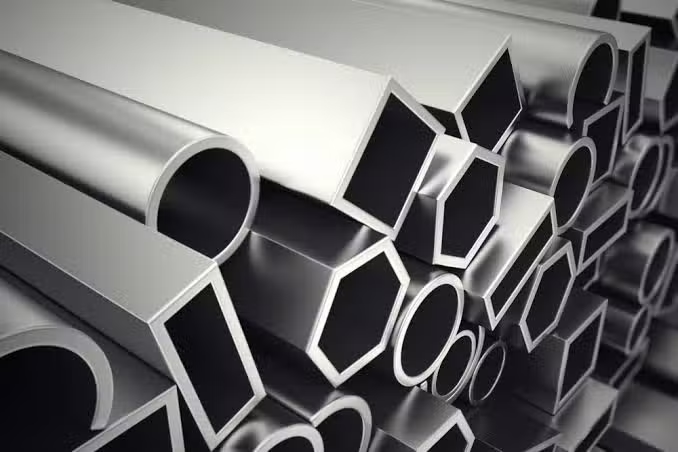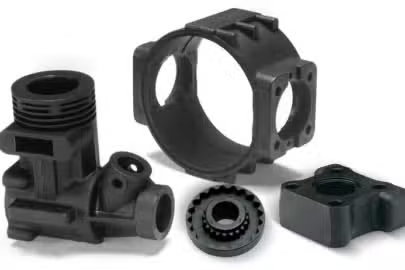Steel is one of the world’s greatest metals, formed by mixing iron with other metals and nonmetal components. The goal of using this combination to make steel is to achieve distinct chemical characteristics for certain purposes. When selecting materials for CNC machining of steel, the qualities of alloy steel and carbon steel should be addressed. There are two types of steel: alloy steel and carbon steel. Understanding the differences between alloy steel and carbon steel allows us to use them effectively in our respective industries and reap the benefits.
Steel selection for CNC machined parts and components is quite challenging. In this post, we will look at the distinctions between alloy and carbon steel, as well as the varieties, applications, alloying components, and qualities.
What is Alloy Steel?
Alloy steel is an iron-based substance (that also contains carbon) with at least one additional element added to it. These elements are added to increase the mechanical or physical qualities of steel, such as hardness, strength, and corrosion resistance, and account for 1-50 wt% (weight percentage) of its composition. Alloy steels can be classified in a variety of ways, including their principal alloying elements (e.g., stainless steel contains a lot of chromium) and the percentage of each alloying element in the steel. For example, high-alloy steel may include more than 8% alloying elements, but low-alloy steel will have fewer.

Adding different elements and varying amounts gives the alloy steel distinct qualities. However, the most prevalent ones are durability, high strength and performance, and corrosion and weather resistance. Chromium or nickel is routinely added to steel to increase its durability or corrosion resistance. Less frequent elements such as lead, tin, and zirconium can also be utilised. Most steels, including those used for welding, have a carbon content of less than 0.35 wt%, and some may be as low as 0.15 wt%. Other types of steel, such as tool steels, can have substantially higher carbon content, often ranging from 0.7 to 1.5 wt%.
Types
Alloy steel is classified into two main groups, and they are :
- High-Alloy Steel: It contains a high amount of alloying elements. The most prevalent type of high alloy steel is stainless steel, which can contain up to 12% chromium. Chromium produces a thin oxide coating outside of the steel, known as the latent layer. The high concentration of chromium enables long-term erosion resistance. This type of alloy is slightly more expensive than low-alloy steel. As a result, it is most commonly used in autos and industrial equipment.
- Low-Alloy Steel: It contains a low percentage of alloying elements, ranging from 1 to 5%. The strength and applicability of this steel vary depending on the alloy utilised. Furthermore, large-diameter flanges employ this sort of alloy to achieve certain mechanical qualities. As a result, low alloy steel is suitable for a wide range of applications, including studding outlet production and seamless rolled ring forging.
Applications
Carbon steel is versatile and widely used in various industries due to its strength and affordability. Here are some key applications:
- Construction: Carbon steel is used in structural frameworks for buildings, bridges, and tunnels. Its durability ensures long-lasting support.
- Automotive Industry: Because of its high strength-to-weight ratio, steel is a primary material for car bodies, chassis, and engine components.
- Tools and Machinery: High-carbon steel is ideal for making cutting tools, drills, and industrial equipment. Its hardness and edge retention are key features.
- Pipes and Tubing: Medium-carbon steel is commonly used for pipes in transporting water, gas, and oil due to its toughness and resistance to pressure.
- Kitchenware: Carbon steel is used in knives, cookware, and cast iron pans. It offers excellent sharpness and heat retention.
What is Carbon Steel?
Carbon steels are iron-carbon alloys that may contain significant amounts of additional alloying elements. Plain carbon steels are iron-carbon alloys with characteristics primarily determined by the presence of carbon. Some incidental elements, such as manganese, silicon, sulphur, and phosphorus, are present in trace amounts due to the manner of manufacturing steels and do not affect the mechanical qualities. Adding a little non-metallic carbon to iron sacrifices its high ductility for increased strength.

Steel is one of the most useful and common ferrous alloys in modern use due to its extremely high strength while maintaining substantial toughness. It can also be significantly altered by heat treatment. There are hundreds of metal alloys with various compositions and heat treatments. The mechanical properties are sensitive to the carbon content, which is typically less than 1.0 wt%.
Types
Here are some of the types of carbon steel:
- Low-carbon steel: This is the most popular and commonly utilised type of carbon steel. It has less than 0.25 percent carbon content. Low-carbon steel is often weaker and softer, but it is also easily welded and ductile, making it ideal for low-cost machining and welding applications.
- Medium-Carbon Steel: With carbon concentrations ranging from 0.25% to 0.6% and manganese content ranging from 0.6% to 1.65%, heat treatment can improve the mechanical characteristics of these metals. Medium-carbon steel is stronger but less ductile and robust than low-carbon steel.
- High Carbon Steel: This is the hardest type of carbon steel, with strong wear resistance, low ductility, and constant hardening and temper. Furthermore, their carbon and manganese contents range from 0.6-1.25% and 0.3-0.9%, respectively.
Applications
Alloy steel, which contains additional elements like chromium, nickel, and molybdenum, offers enhanced properties for specific uses. Here are some common applications:
- Aerospace: Alloy steel is used in aircraft frames, turbines, and landing gear due to its high strength, heat resistance, and light weight.
- Automotive Industry: Steel is used to make engine components, gears, and crankshafts. Its strength and wear resistance are crucial for performance.
- Energy Sector: Alloy steel is found in power plants, especially for pipes, boilers, and valves. It can withstand high temperatures and pressures.
- Construction Equipment: Heavy machinery like cranes, bulldozers, and excavators often use alloy steel for components that require high strength and durability.
- Tools and Dies: High-alloy steel is ideal for making tools like molds, dies, and cutters, offering excellent hardness and resistance to wear.
Alloy Steel vs Carbon Steel: Differences Comparison
Here are the differences between carbon steel vs alloy steel:
Composition
Alloy steel and carbon steel are two commonly used materials, but they differ significantly in terms of composition, properties, and their range of applications. The primary difference lies in their composition. Carbon steel is mainly made of iron and carbon, with little to no other elements. The carbon content typically ranges from 0.05% to 2%, which gives it its strength but limits other qualities like corrosion resistance.
On the other hand, alloy steel contains additional elements like chromium, nickel, molybdenum, and vanadium. These elements enhance specific properties such as strength, toughness, and resistance to corrosion, making alloy steel more versatile for a variety of demanding applications.
Strength and Durability
When it comes to strength and durability, carbon steel is strong and durable for most general uses. Still, it’s more prone to rust and corrosion, especially if exposed to moisture or chemicals. Alloy steel, however, is known for its superior strength and durability.
The alloying elements contribute to its ability to withstand higher stress, pressure, and temperature, making it ideal for high-performance applications like aerospace or heavy machinery.
Corrosion Resistance
As for corrosion resistance, carbon steel is less resistant to rust and corrosion compared to alloy steel. Without proper treatment or coating, carbon steel can degrade in harsher environments. In contrast, alloy steel, particularly stainless steel with added chromium, is far more resistant to corrosion, making it suitable for use in marine and chemical industries.
Heat Resistance
In terms of heat resistance, carbon steel offers moderate resistance to heat. However, the higher the carbon content, the more brittle it becomes at elevated temperatures. Alloy steel, on the other hand, excels in this area. The presence of elements like chromium and molybdenum helps alloy steel retain its strength at high temperatures, which is why it is used in applications that involve heat, such as in power plants or engines.
Cost
The cost also plays a role in their distinction. Carbon steel is typically more affordable because it requires fewer processing steps and has a simpler composition. Alloy steel, however, tends to be more expensive due to the added alloying elements and the more complex processes involved in its production.
Applications
When considering their applications, carbon steel is widely used in industries like construction, automotive, and tools where extreme heat resistance or corrosion protection isn’t necessary. It is an ideal choice for general-purpose items like structural beams, car parts, and machinery that don’t require high levels of toughness.
With its enhanced properties, alloy steel is more suitable for high-performance industries. It’s commonly used in the aerospace, automotive, and energy sectors, where the material needs to withstand harsh conditions, such as high stress, extreme temperatures, or corrosive environments.
Contrast Table
Below is a table showing the summary of the differences between alloy steel vs carbon steel:
| Features | Alloy Steel | Carbon Steel |
| Composition | It contains additional elements like chromium, nickel, molybdenum, etc. | It is primarily made of iron and carbon, with little to no other elements |
| Strength and Durability | Superior strength, wear resistance, and durability due to alloying elements | Strong, but more prone to rust and corrosion without proper treatment. |
| Corrosion Resistance | Highly resistant to corrosion, especially when alloyed with chromium | Less resistant to rust and corrosion, requires coatings or treatment. |
| Heat Resistance | Excellent heat resistance, especially with chromium and molybdenum. | Moderate heat resistance becomes brittle at high temperatures with high carbon content. |
| Cost | It is more expensive due to the added alloying elements and complex manufacturing processes. | Generally cheaper due to simpler composition and fewer processing steps |
| Applications | It is used in high-performance industries like aerospace, automotive, and energy, where strength, heat resistance, and corrosion protection are important. | Common in construction, automotive, and tools where extreme heat or corrosion resistance is not important. |
Conclusion
Alloy steel and carbon steel are both essential materials, but they serve different purposes due to their distinct properties. Carbon steel is a cost-effective option, widely used in applications where high strength and durability are needed without the need for advanced resistance to heat or corrosion. It is perfect for general-purpose uses like construction, automotive parts, and tools.
On the other hand, alloy steel offers superior performance in demanding environments. Its enhanced strength, corrosion resistance, and heat tolerance make it ideal for high-performance sectors such as aerospace, energy, and automotive industries. While it comes at a higher cost, its ability to withstand extreme conditions justifies the investment in specialized applications.
Choosing between alloy steel and carbon steel depends on the specific requirements of the project, including factors like cost, performance, and environmental conditions.
Great, Together



